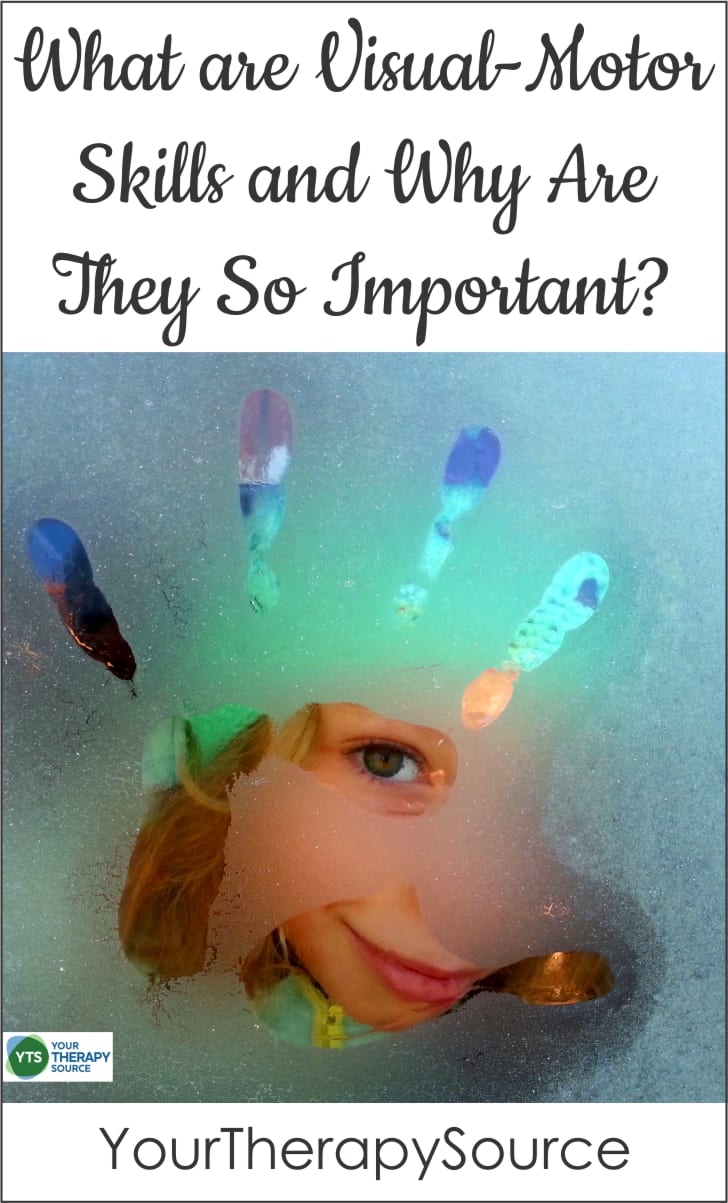Visual Motor Skills – What are they and why are they important?
What are Visual Motor Skills?
Visual motor skills, otherwise known as visual motor integration is the ability to interpret visual information and respond with a motor action. For example, you see a baseball and you respond by moving your hands to catch the baseball. Research indicates that visual motor skills are related to academic performance and eye-hand coordination skills.
Why are Visual Motor Skills Important?
Visual motor integration is crucial for coordination activities. If visually presented information is not perceived correctly, the muscles will get incorrect messages resulting in inappropriate motor responses. Children who have deficits in visual-motor integration may exhibit problems with participating in sports, eye hand coordination skills, eye-foot coordination skills, bilateral coordination (combining both sides of the body together), body awareness, activities of daily living (i.e. getting food on a fork), copying visual information, reading, drawing, handwriting, lining up math problems, geometry, speed of complete motor tasks, etc.
What Does the Research Say About the Importance of Visual Motor Integration Skills?
Did you know that visuomotor integration in kindergarten alone can predict later reading and math? After studying 259 kindergarteners through second graders, researchers reported that executive function and visuomotor integration tend to be delayed in socioeconomically disadvantaged children and can explain nearly half the achievement gap at kindergarten entry and visuomotor integration in kindergarten alone predicted later reading and math (Brock & Grissmer, 2018).
Other research indicates that preschool children’s visual-motor integration and object manipulation skills are related to executive function skills and social behaviors (MacDonald et. al., 2016)
For older children, performance on a visual analysis and visual motor integration task were significantly related to academic performance in 7-, 8- and 9-year-olds (Taylor, 1999).
Visual motor skills play an important role in handwriting. Visual-motor integration skills have been shown to be related to the ability to copy letters legibly (Daly et. al, 2003).
When it comes to written assignments, reduced visual-motor integration may contribute to the poor spatial organization of written work as well (Barnhardt et. al, 2005).
Eye-hand coordination skills in children have also been shown to be related to math, reading and writing attainment (Giles et al, 2018).
What are Visual Motor Integration Activities You Can Do to Help?
Children need adequate visual perceptual skills to function properly in school and at home. If you have concerns about your child’s visual skills, be sure to start out by having your child undergo a thorough vision examination by an optometrist or an ophthalmologist (medical doctor).
Here are some activities that encourage visual motor integration:
- practice, practice, practice balls skills – catching, throwing, kicking and hitting. Start with large balls and
slower speed progressing to smaller balls and faster speed. - practice large movements to form letters and numbers (i.e. air writing forming the letters large in the air using your whole arm and hand).
- use stencils, dot to dot puzzles, mazes and easy coloring books (emphasizing coloring in the lines).
- practice lacing activities – string beads, simple sewing projects and lacing cards.
- copy designs using wooden blocks, large interlocking blocks, small interlocking blocks, peg boards, etc.
- play movement games that encourage right/left discrimination, avoiding obstacles, stopping/starting, etc.
- print and practice various visual motor worksheets.
Here are 10 free visual motor activities printables – just print, grab a pencil and you are all set!!!
1. Visual-Motor Exercise – download the directions and free longer maze to complete
2. 2 Pages from Visual Motor Workbook – from the complete Visual Motor Workbook
3. Follow the Path – copy the dot to dot diagrams to practice visual motor and visual-spatial skills.
4. Letter and Shape Maze – download two mazes: circle and the letter c
5. Connect Puzzle – challenge visual motor, visual-spatial and motor planning skills with this puzzle.
6. Graph Paper Drawing – download a 10×10 grid drawing to copy to practice visual motor, visual spatial and visual closure skills.
7. Crossing Path Puzzle – practice visual motor, visual spatial and motor planning skills all with this pencil and paper game.
8. Frog Grid Drawing – download this puzzle to work on spatial reasoning and visual motor skills.
9. Patterns Freebies – this freebie includes 7 pages to practice visual motor skills!
10. Lines, Lines and More Lines Freebie – this includes simple visual-motor activities and a construction themed more challenging visual motor game.
What to Do If Your Child Has Difficulties with Visual Motor Skills?
If your child has difficulties with visual motor integration skills try the following:
- practice, practice, practice!
- keep worksheets clear, uncluttered and concise.
- try to cover up all the problems except the one that is being worked on to see if that helps.
- highlight or darken important information.
- use a multisensory approach (i.e. activities that require using more than just the visual system such as creating a video presentation instead of handwritten assignment).
- allow a child to give an answer orally instead of written.
- reduce the amount of materials that need to be copied from the board.
- ask for your child to be provided with copies of class notes.
- focus on the quality of the work rather than the quantity.
Read more about recent research regarding visual motor integration and academics.
References:
Barnhardt, C., Borsting, E., Deland, P., Pham, N., & Vu, T. (2005). Relationship between visual-motor integration and spatial organization of written language and math. Optometry and Vision Science, 82(2), 138-143.
Brock, L. L., Kim, H., & Grissmer, D. W. (2018). Longitudinal Associations Among Executive Function, Visuomotor Integration, and Achievement in a High‐Risk Sample. Mind, Brain, and Education, 12(1), 23-27.
Daly, C. J., Kelley, G. T., & Krauss, A. (2003). Relationship between visual-motor integration and handwriting skills of children in kindergarten: A modified replication study. American journal of occupational therapy, 57(4), 459-462.
Giles, O. T., Shire, K. A., Hill, L. J., Mushtaq, F., Waterman, A., Holt, R., … & Mon-Williams, M. (2018). Hitting the target: Mathematical attainment in children is related to interceptive timing ability. Psychological Science.
MacDonald, M., Lipscomb, S., McClelland, M. M., Duncan, R., Becker, D., Anderson, K., & Kile, M. (2016). Relations of Preschoolers’ Visual-Motor and Object Manipulation Skills With Executive Function and Social Behavior. Research Quarterly for Exercise and Sport, 1-12.
Taylor, M. K. (1999). Relationship between visual motor integration skill and academic performance in kindergarten through third grade. Optometry and vision science: official publication of the American Academy of Optometry, 76(3), 159-163.
Read more about visual-motor skills in an article I contributed to in Parents magazine.



